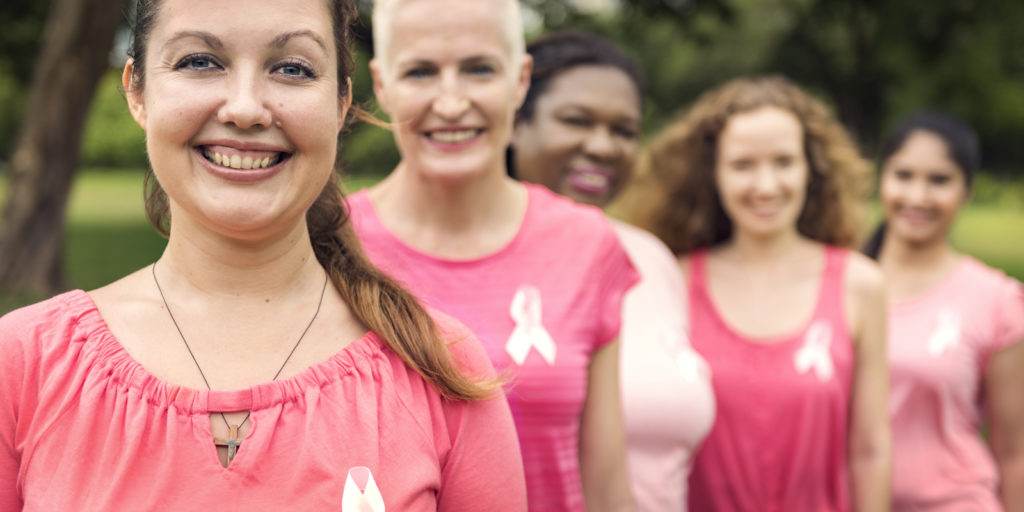The burden of breast cancer in Australia
Breast cancer is a big concern in Australia. It is the most common cancer (excluding skin cancer) and the second deadliest cancer (after lung cancer) in Australian women.1 In 2018 alone there were an estimated 18,235 new cases of breast cancer (of which 148 were in males) and 3,157 breast cancer-related deaths.2
Who is at risk?
There are different types of risk factors for breast cancer, some of which can be changed, and some which cannot. The major risk factors for women developing breast cancer include:3
- Increasing age;
- A personal history of an abnormal breast tissue growth (ie. atypical hyperplasia or lobular carcinoma in situ);
- A strong family history of breast cancer or mutation in a breast cancer predisposition gene (eg. the BRCA genes);
- Previous radiotherapy (eg. for a previous cancer).
Other risk factors include a history of taking particular medications (ie. combined oral contraceptive pill, combined menopausal hormone therapy), early onset of menarche, late onset of menopause, having a first child at an older age, being obese or overweight and having an increased alcohol consumption.4
It is important to note that breast cancer risk is not evenly spread in the population. This means that the majority of women only have a low lifetime risk, whereas a small percentage of women have a much higher risk (sometimes up to 80%).3 Therefore, it is very important that you talk to your GP so that together you can work out what your risk is and act accordingly.3
Ask your GP about Breast Cancer
They can advise you on your level of risk and if necessary arrange an early screening
Preventing breast cancer
There are several lifestyle factors that have been shown to reduce the risk of developing breast cancer. These include:3
- Being physically active;
- Ensuring an adequate intake of folate. Folate-rich foods include green leafy vegetables (eg. spinach, broccoli and asparagus), fruits (such as strawberries, oranges and bananas) and legumes (eg. chickpeas, beans and lentils);5
- Following a Mediterranean diet, which comprises:6
- A high monounsaturated (eg. olive oil) to saturated fat (eg. fatty red meat) ratio, as well as consuming high amounts of legumes, fruits and vegetables, and grains and cereals;
- Moderate amounts of fish, white meat and low-fat dairy;
- Low amounts of red and processed meat, eggs, sweets and desserts, and sweetened beverages.
- Maintaining a normal body mass index (BMI) if you are postmenopausal;
- Limiting your alcohol consumption.
If you are at a moderate or high risk of developing breast cancer, your doctor might talk to you about additional steps, including taking risk-reducing medications. In certain cases, your doctor might even recommend risk-reducing surgery.3 Naturally, this is a huge decision to make and it is important that your doctor takes the time to thoroughly explain why they have made this recommendation.
Breast cancer screening
Screening for breast cancer, which allows for early detection and appropriate treatment, can significantly improve survival. A recent study showed that Australia’s breast cancer screening program reduces breast cancer mortality by between 21 and 28 percent. However, screening is not without its risks. Mammography, the recommended screening tool for breast cancer, can lead to over-diagnosis (this is diagnoses of cancers which, if left undetected, would not have caused any health issues in the patient) and subsequently unnecessary treatment and distress. Therefore, the age to start screening, as well as the type and frequency of screening, should always be personalised.7
|
Individual risk level* |
What should be done? |
How often?3 |
|---|---|---|
|
Average or only slightly higher risk (>95% of the female population)
|
Visit GP to clarify risk
Breast awareness
Mammogram
|
Every two years from 50-74 years of age |
|
Moderately increased risk (<4% of the female population)
|
Visit GP to clarify risk
Breast awareness
Mammogram
Consider consultation with a family cancer clinic
|
At least every two years from 50-74 years of age.
Annual mammograms from 40 years may be considered
|
|
Potentially high risk (<1% of the female population) |
Visit GP to clarify risk
Referral to cancer specialist or family cancer clinic to arrange personalised management plan
|
Personalised program |
*Your GP can help you determine your breast cancer risk level.
What is a mammogram?
A screening mammogram is an X-ray of the breast used to check for breast cancer in women who have no signs or symptoms. A diagnostic mammogram, on the other hand, is used to check for breast cancer after a lump (or another sign or symptom) has already been found.8
During a mammogram, each breast is placed between two X-ray plates (which help to spread the breast tissue out). This procedure can be uncomfortable, but usually will only take about 20 seconds.8
Ask your GP about Breast Cancer
They can advise you on your level of risk and if necessary arrange an early screening
References
Cancer Council Australia (online). Breast cancer [accessed 23 Jan 2019]. Available from: URL link
Australian Government Cancer Australia (online). Breast cancer statistics [accessed 23 Jan 2019]. Available from: URL link
The Royal Australian College of General Practitioners. Guidelines for preventive activities in general practice. 9th edn, updated. East Melbourne, Vic: RACGP, 2018.
Australian Government Cancer Australia (online). Breast Cancer Risk Factors At a Glance [accessed 24 Jan 2019]. Available from: URL link
Dietitian’s Association of Australia (online). Folate: crucial for women under 50 [accessed 23 January 2019]. Available from: URL link
The Royal Australian College of General Practitioners (online). Mediterranean diet for reducing cardiovascular disease risk [Accessed 23 January 2019]. Available from: URL link
Cancer Council Australia (online). Breast cancer screening [accessed 23 Jan 2019]. Available from: URL link
Cancer Council Australia (online). Mammogram [accessed 23 Jan 2019]. Available from: URL link
All content and media on the HealthEngine Blog is created and published online for informational purposes only. It is not intended to be a substitute for professional medical advice and should not be relied on as health or personal advice. Always seek the guidance of your doctor or other qualified health professional with any questions you may have regarding your health or a medical condition. Never disregard the advice of a medical professional, or delay in seeking it because of something you have read on this Website. If you think you may have a medical emergency, call your doctor, go to the nearest hospital emergency department, or call the emergency services immediately.









